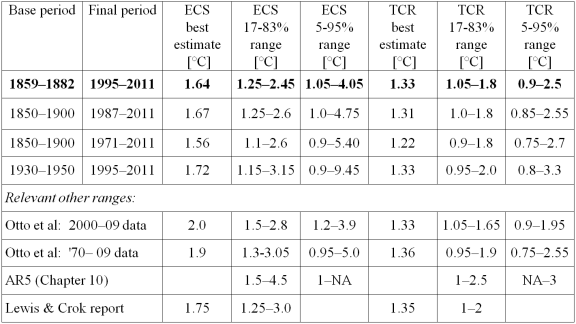GWPF Press Release: A new paper published in the prestigious journal Climate Dynamics finds that the effect of carbon dioxide emissions on global temperatures is likely to be even smaller than previously thought.
Earlier this year, in a widely discussed report for the Global Warming Policy Foundation, climate researcher Nic Lewis and science writer Marcel Crok put forward a new estimate of the Earth’s climate sensitivity based on observational data, finding that it was much less alarming than suggested by computer simulations of the Earth’s climate.
Now, Lewis and well known American climate science professor Judith Curry have updated the Lewis and Crok report estimates using the latest empirical data, a more sophisticated methodology and an approach to accounting for uncertainties that has been described by one independent reviewer as “state of the art”. Their findings fully support the modest estimates of climate sensitivity and future warming given in the Lewis and Crok report, and compared with that report make it look even less likely that the substantially higher estimates based on computer simulations are correct.
“Our results, which use data from this year’s IPCC fifth assessment report, are in line with those of several recent studies based on observed centennial warming and strongly suggest complex global climate models used for warming projections are oversensitive to carbon dioxide concentrations,” Nic Lewis said.

Best sensitivity estimates are medians (50% probability points). Ranges are to the nearest 0.05°C
Nicholas Lewis & Judith A. Curry (2014) The implications for climate sensitivity of AR5 forcing and heat uptake estimates, Climate Dynamics 25 September 2014
Abstract
Energy budget estimates of equilibrium climate sensitivity (ECS) and transient climate response (TCR) are derived using the comprehensive 1750–2011 time series and the uncertainty ranges for forcing components provided in the Intergovernmental Panel on Climate Change Fifth Assessment Working Group I Report, along with its estimates of heat accumulation in the climate system. The resulting estimates are less dependent on global climate models and allow more realistically for forcing uncertainties than similar estimates based on forcings diagnosed from simulations by such models. Base and final periods are selected that have well matched volcanic activity and influence from internal variability. Using 1859–1882 for the base period and 1995–2011 for the final period, thus avoiding major volcanic activity, median estimates are derived for ECS of 1.64 K and for TCR of 1.33 K. ECS 17–83 and 5–95 % uncertainty ranges are 1.25–2.45 and 1.05–4.05 K; the corresponding TCR ranges are 1.05–1.80 and 0.90–2.50 K. Results using alternative well-matched base and final periods provide similar best estimates but give wider uncertainty ranges, principally reflecting smaller changes in average forcing. Uncertainty in aerosol forcing is the dominant contribution to the ECS and TCR uncertainty ranges.
Full paper of the accepted manuscript is available, along with data and code here